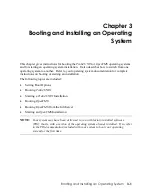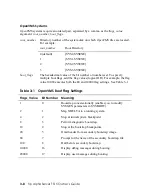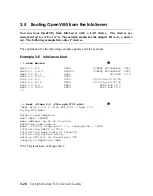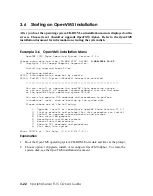
Examples
In the following
OpenVMS
example,
root_number
is set to 2 and
boot_flags
is set to 1.
With this setting, the system will boot from root directory [SYS2.SYSEXE] to the
SYSBOOT prompt when you enter the
boot
command.
>>> set boot_osflags 2,1
In the following
OpenVMS
example,
root_number
is set to 0 and
boot_flags
is set to 80.
With this setting, you are prompted for the name of the secondary bootstrap file when you
enter the
boot
command.
>>> set boot_osflags 0,80
3.1.5
eg*0_inet_init, ei*0_inet_init, ew*0_inet_init
The eg*0_inet_init, ei*0_inet_init, or ew*0_inet_init environment variable determines
whether the interface's internal Internet database is initialized from nvram or from a
network server (through the bootp protocol). Legal values are nvram and bootp. The
default value is bootp. Set this environment variable if you are booting Tru64 UNIX
from a RIS server.
To list the network devices on your system, enter the
show device
command. The Ethernet
controllers start with the letters “eg”, “ei” or “ew,” for example, ewa0. The third letter is
the adapter ID for the specific Ethernet controller. Replace the asterisk (*) with the adapter
ID letter when using this
command.
The syntax is:
set eg*0_inet_init
value
or
set ei*0_inet_init
value
or
set ew*0_inet_init
value
The
value
is one of the following:
Nvram
Initializes the internal Internet database from nvram.
Bootp
Initializes the internal Internet database from a network server through the
bootp protocol.
Example
>>> set ewa0_inet_init bootp
Booting and Installing an Operating System
3-9
















































